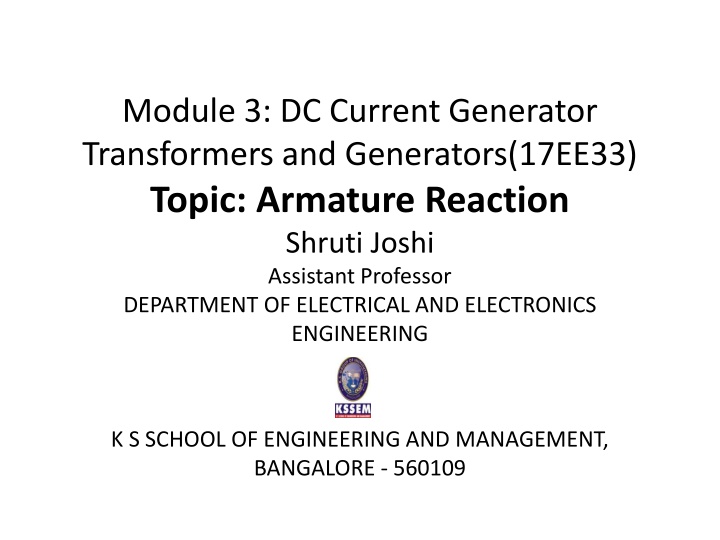
Armature Reaction in Electric Generators
Explore the principles of armature reaction in electric generators, including salient pole and nonsalient pole alternators, two-reaction theory, and phasor diagrams. Watch educational videos for in-depth explanations.
Download Presentation

Please find below an Image/Link to download the presentation.
The content on the website is provided AS IS for your information and personal use only. It may not be sold, licensed, or shared on other websites without obtaining consent from the author. If you encounter any issues during the download, it is possible that the publisher has removed the file from their server.
You are allowed to download the files provided on this website for personal or commercial use, subject to the condition that they are used lawfully. All files are the property of their respective owners.
The content on the website is provided AS IS for your information and personal use only. It may not be sold, licensed, or shared on other websites without obtaining consent from the author.
E N D
Presentation Transcript
Module 3: DC Current Generator Transformers and Generators(17EE33) Topic: Armature Reaction Shruti Joshi Assistant Professor DEPARTMENT OF ELECTRICAL AND ELECTRONICS ENGINEERING K S SCHOOL OF ENGINEERING AND MANAGEMENT, BANGALORE - 560109
In case of nonsalient pole type alternators the air gap is uniform. Due to uniform air gap, the field flux as well as armature flux very sinusoidally in the air gap In nonsalient rotor alternators, air gap length is constant and reactance is also constant. Due to this the m.m.f.s of armature and field act upon the same magnetic circuit all the time hence can be added vectorially. In salient pole type alternators the length of the air gap varies and the reluctance also varies. Hence the armature flux and field flux cannot vary sinusoidally in the air gap. The reluctances of the magnetic circuits on which m.m.fs act are different in case of salient pole alternators
The theory which gives the method of analysis of the distributing effects caused by salient pole construction is called two reaction theory. Professor Andre Blondel has put forward the two reaction theory. According to this theory the armature m.m.f. can be divided into two components as, 1. Components acting along the pole axis called direct axis 2. Component acting at right angles to the pole axis called quadrature axis. The component acting along direct axis can be magnetising or demagnetising. The component acting along quadrature axis is cross magnetising. These components produces the effects of different kinds.
https://www.youtube.com/watch?v=YogaQknnNu0 this is the link to the vedio explaining Armature Reacttion in DC Generators https://www.youtube.com/watch?v=0kaKoNLoHLk : NPTEL vedio By IIT Kharagpur Professor explaining the Armature Reaction in detail
